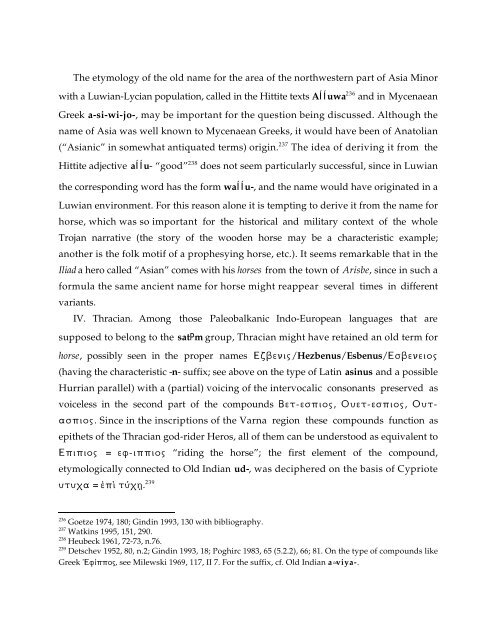Comparative Notes on Hurro-Urartian, Northern Caucasian
Comparative Notes on Hurro-Urartian, Northern Caucasian
Comparative Notes on Hurro-Urartian, Northern Caucasian
You also want an ePaper? Increase the reach of your titles
YUMPU automatically turns print PDFs into web optimized ePapers that Google loves.
The etymology of the old name for the area of the northwestern part of Asia Minor<br />
with a Luwian-Lycian populati<strong>on</strong>, called in the Hittite texts AÍÍuwa 236 and in Mycenaean<br />
Greek a-si-wi-jo-, may be important for the questi<strong>on</strong> being discussed. Although the<br />
name of Asia was well known to Mycenaean Greeks, it would have been of Anatolian<br />
(“Asianic” in somewhat antiquated terms) origin. 237 The idea of deriving it from the<br />
Hittite adjective aÍÍu- “good” 238 does not seem particularly successful, since in Luwian<br />
the corresp<strong>on</strong>ding word has the form waÍÍu-, and the name would have originated in a<br />
Luwian envir<strong>on</strong>ment. For this reas<strong>on</strong> al<strong>on</strong>e it is tempting to derive it from the name for<br />
horse, which was so important for the historical and military c<strong>on</strong>text of the whole<br />
Trojan narrative (the story of the wooden horse may be a characteristic example;<br />
another is the folk motif of a prophesying horse, etc.). It seems remarkable that in the<br />
Iliad a hero called “Asian” comes with his horses from the town of Arisbe, since in such a<br />
formula the same ancient name for horse might reappear several times in different<br />
variants.<br />
IV. Thracian. Am<strong>on</strong>g those Paleobalkanic Indo-European languages that are<br />
supposed to bel<strong>on</strong>g to the satPm group, Thracian might have retained an old term for<br />
horse, possibly seen in the proper names Ezbeniw/Hezbenus/Esbenus/Esbeneiow<br />
(having the characteristic -n- suffix; see above <strong>on</strong> the type of Latin asinus and a possible<br />
Hurrian parallel) with a (partial) voicing of the intervocalic c<strong>on</strong>s<strong>on</strong>ants preserved as<br />
voiceless in the sec<strong>on</strong>d part of the compounds Bet-espiow, Ouet-espiow, Out-<br />
aspiow. Since in the inscripti<strong>on</strong>s of the Varna regi<strong>on</strong> these compounds functi<strong>on</strong> as<br />
epithets of the Thracian god-rider Heros, all of them can be understood as equivalent to<br />
Epipiow = ef-ippiow “riding the horse”; the first element of the compound,<br />
etymologically c<strong>on</strong>nected to Old Indian ud-, was deciphered <strong>on</strong> the basis of Cypriote<br />
utuxa = §p‹ tÊx˙. 239<br />
236 Goetze 1974, 180; Gindin 1993, 130 with bibliography.<br />
237 Watkins 1995, 151, 290.<br />
238 Heubeck 1961, 72-73, n.76.<br />
239 Detschev 1952, 80, n.2; Gindin 1993, 18; Poghirc 1983, 65 (5.2.2), 66; 81. On the type of compounds like<br />
Greek ÉEf¤ppow, see Milewski 1969, 117, II 7. For the suffix, cf. Old Indian a≈viya-.





